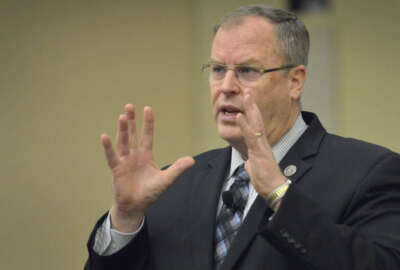
State, local govts face workforce competition from private sector
Just as it is a workforce challenge for federal agencies, state and local governments are also forced to compete with the private sector for talent.
Best listening experience is on Chrome, Firefox or Safari. Subscribe to Federal Drive’s daily audio interviews on Apple Podcasts or PodcastOne.
Telework is on the rise. Engineering and technical positions are difficult to fill. And it’s hard to compete with private sector salaries. Those tropes about the federal workforce also apply to people working for state and local government. For more on these and other findings, Gerald Young, senior research associate at the Center for State and Local Government Excellence, joined Federal Drive with Tom Temin.
Interview transcript:
Tom Temin: Mr. Young, good to have you on.
Gerald Young: Well, thank you. Glad to be here.
Tom Temin: And it’s always fun to compare what’s going on at the non federal level with the federal level. And you found that, let’s start with telework, this is an annual survey, correct? And people at the state and local level are working more than ever at teleworking. A surprise there or is it just because of the pandemic?
Gerald Young: Not a surprise at all. In fact, we have been doing the survey since 2009. And telework is something that we’ve seen on the rise, I’d say since about 2016. But it’s very often been a key practice in not only reacting to emergency situations like we’re in right now, but also in attracting and retaining a workforce that, you know, sees that as a benefit to the employee, and often a benefit to the community that they’re serving and that it may be something that allows them to expand their available working hours.
Tom Temin: Now, at the federal level, the Trump administration has pretty tough ways of trying to reduce the amount of telework going on, you know, agency by agency, Social Security, Agriculture Department and a few others, they’ve really tried to actively cut back. At the state level and understanding that every entity is unto itself, but is the trend toward more telework, as you were saying since 2016, so after the pandemic is over and people are back in the offices, would you expect them to continue the upward trend toward teleworking?
Gerald Young: Yes, I think that the practice of telework will continue and state agencies are far more likely at this point to be offering telework for their eligible employees than local governments are, although both have been increasing. I think where we will probably see the most changes both in those organizations that had never offered telework before that have now had experience in it, and will decide to continue because they see benefits in doing so. And also in those agencies that continue to have social distancing concerns that need to look at the geography of their office space and make adaptations to allow for perhaps employees to stagger days that they might be working from home
Tom Temin: And just give us some of the numbers across the state and local universe that you have surveyed. How many people or what percentage of people are teleworking on average?
Gerald Young: Well, we hadn’t been looking at the percentage of people who’ve been telework so much as the organizations that offer telework, and 64% of state agencies that responded to our most recent surveys were offering regular telework to their employees, about 19% of local agencies were doing the same. But this particular survey that we’ve just concluded, started in February, so a lot of the data that we were collecting was pre COVID. And again, what we’re looking to do is capture this type of data on an annual basis. So we’ll be very curious to continue watching those trends post COVID as well.
Tom Temin: And of those two thirds of say, the state level agencies that do offer telework, is it certain departments that tend to do it certain types of governmental functions?
Gerald Young: It’s not necessarily limited to specific departments. And one of the areas that we have surveyed is whether there are certain areas that are excluded from telework, and we might anticipate that some of those are the more high touch or public facing agencies, but that’s not necessarily the case. Public Safety, obviously, is something that needs to respond when there is an emergency, but only 41% of the respondents to the survey indicated the public safety is entirely excluded from flexible work practices. That may be that yes, it’s a little bit laughable to think that somebody is going to fight a fire at your house from their own house. But there are a lot of ways in which employees within let’s say police or fire might be able to either telework or have flexible schedules that allow perhaps for you know, for 10 hour work days as opposed to five eight hour work days. You know, allowing for rotating shifts to be covering the needs not necessarily within direct patrol, but perhaps in back office operations. Public works, parks and recreation, public health, all of those areas also have a very high percentage of organizations that say that they do not categorically exclude those employees from their flexible work, right.
Tom Temin: And let’s talk about the issue of attracting people to government. And this is something that the federal level is always expressing concern about, but this is also happening at the non federal level, finding engineering, scientific, those kinds of technical jobs, finding people that want to work for government. Tell us more about your findings there.
Gerald Young: Oh, definitely. You know, attracting people to any particular employer is always a challenge and with government, there are certain fields like public safety, that have traditionally been kind of not necessarily immune to the challenges of attracting a workforce but they’ve had a particular culture that people find attractive and want to be of service to, and therefore, flock to those professions. That’s not necessarily continuing at this point. Police and fire both have challenges at attracting people to come to positions that perhaps a few years ago there were people beating down the door for but I think more so what we’ve been finding in our survey is that positions like engineering like skilled trades, even like manual labor, when we’re looking at public works employees 25% or more of the agencies that we’re talking to are saying that they are finding those to be hard to recruit positions, and particularly in fields where there is competition with the private sector. If you are looking for an engineering position, and you have the option to work in the private sector or the public sector, something has to make that difference for you. And it may be that you’re able to command a higher salary in the private sector, but that’s where public sector employers, whether that’s state, local or federal, have to offer something else. And it’s not necessarily compensation because most of the organizations that we’ve spoken to say that they don’t see compensation as where they are most competitive. Typically it is either on the benefits side, or on the more intangible side. And benefits we typically think of as being pensions or, you know, some other type of financial benefit that’s offered. But there have been a lot of changes in the pension sphere over the last 10 or 20 years as well and pensions may not be quite the attractor as they once might have been. But when you have benefits that allow you additional flexibility, whether it’s in telework or in some other capacity in your job, perhaps the ability to cross train, and get additional experience in other areas to get that type of professional development and career development that you’re seeking, that might be what helps you to make that choice between employers. And it also might be that, you know, looking at the difference that you can make, particularly, I think, in local government, where you are so close to the people that you are serving, it might even be at a community that you grew up in, that you find more of a mission in the employer that you’re choosing.
Tom Temin: Interesting because I was looking at the list of jobs that are hard to fill. And it’s just surprising that what you say is borne out by these facts, engineering, information, technology, policing, are difficult to fill. And right up in there is maintenance and manual labor work. And so I guess the market has changed a lot, hasn’t it? This is almost a statement on the economy as a whole, isn’t it?
Gerald Young: Well, it definitely is when we started doing The survey in 2009, you know, all of those positions were ranked as fairly easy to recruit for. I don’t think any of them were above 5% of respondents saying that they were difficult to fill. Whereas, you know, as you indicated, most of those currently are 20% or more of organizations saying that they’re difficult to fill. And I think more telling is that as you look at some of those positions, like engineers or registered nurses, 60 to 70 to 80% are saying that they’re tracting fewer qualified applicants than they have available positions. So that’s really the challenge to find those applicants who are interested in those positions, but are also potentially just even aware that those positions exist, and that’s where times gone by it might have been that, you know, advertising in the local newspaper was sufficient to get the word out that you had a position available, but much more so at this point, it’s the social media, it’s the online recruitment videos that you might be posting. And it’s even the more low tech end of that spectrum with the employee referrals that are really getting the word out that not only do these opportunities exist, but they might be more rewarding than what somebody might be able to find in the private sector.
Tom Temin: But in the meantime, it would seem to mitigate then towards more outsourcing just hiring contractors to do what you can’t find people to do natively for the government.
Gerald Young: Well, outsourcing is certainly a part of the equation, there is some gig hiring that is going on within state and local government. It’s definitely not the level of full time hiring or even part time hiring, but it is going on, it’s going on much more so in certain fields than in others. office work is definitely a part of that. Engineering, and IT certainly can be a part of that. But you know, again, for obvious reasons, things like police and fire you don’t often hire somebody just for a week’s work and expect that that’s going to solve all the issues that you have in full time recruitment.
Tom Temin: Indeed not. Gerald Young is senior research associate at the Center for State and Local Government Excellent. Thanks so much for joining me.
Gerald Young: Thank you.
Copyright © 2025 Federal News Network. All rights reserved. This website is not intended for users located within the European Economic Area.
Tom Temin is host of the Federal Drive and has been providing insight on federal technology and management issues for more than 30 years.
Follow @tteminWFED





